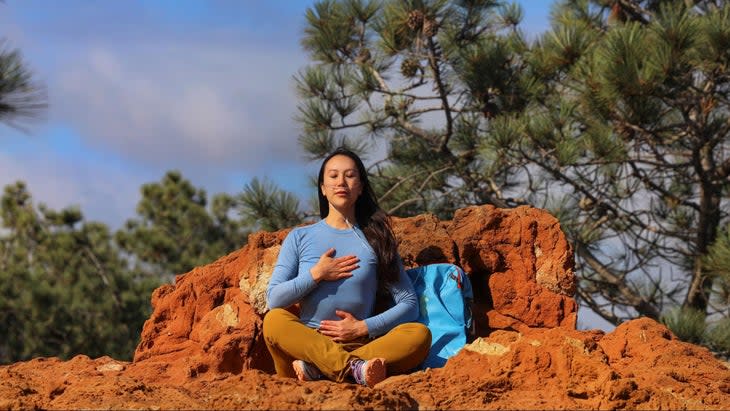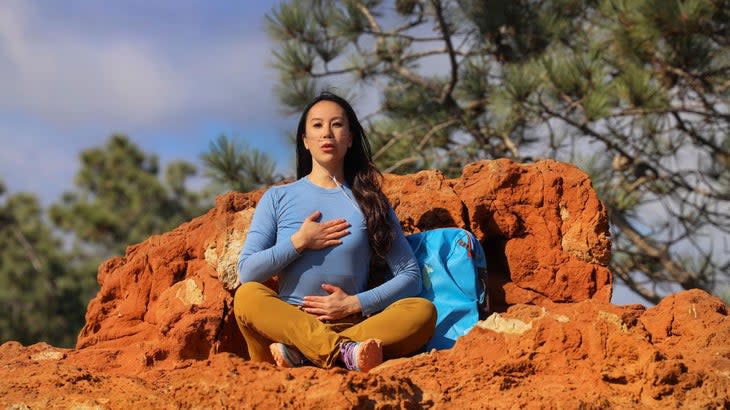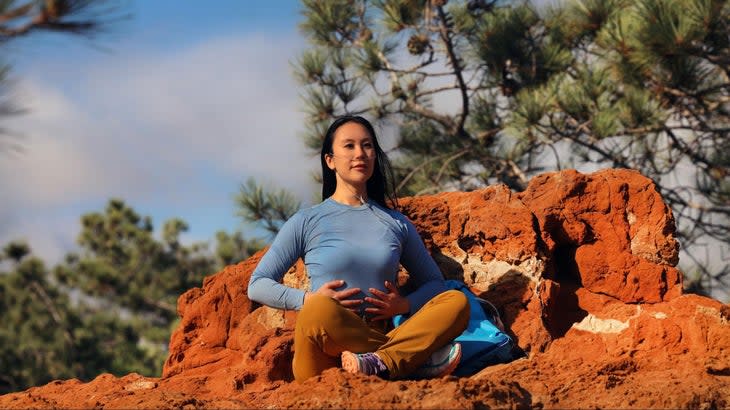Can Breathwork Help You Avoid Altitude Sickness?
This article originally appeared on Outside
For those of us with adventurous spirits, few experiences can match the exhilaration of ascending majestic mountains and basking in awe-inspiring views. But pursuing this breathtaking beauty may come with the hidden peril of altitude sickness, a condition triggered when your body struggles to adapt as oxygen levels diminish the higher you go.
As a dedicated yoga practitioner, I've often turned to my physical practice to prepare for and support hiking expeditions and to recover afterward. But when considering effective strategies for acclimatizing to high altitudes, a compelling question arose: Can breathwork aid in preparing for high-altitude challenges?
What Is Altitude Sickness?
Also known as acute mountain sickness (AMS), altitude sickness occurs when your body struggles to adapt to the low-oxygen environment you encounter at high altitudes. Symptoms include headache, nausea, fatigue, dizziness, shortness of breath, and in serious cases, difficulty breathing, severe headaches, and confusion.
The condition typically manifests at elevations above 8,000 feet (2,400 meters). As you ascend, the air becomes thinner, resulting in reduced oxygen concentration. To compensate, your body increases your breathing rate to ensure you take in enough oxygen and eliminate carbon dioxide. However, excessive breathing, called hyperventilation, can affect oxygen delivery to your muscles and vital organs, causing symptoms like dizziness, tingling sensations, and muscle spasms. Oxygen levels that are too low can potentially result in serious conditions such as high altitude pulmonary edema (HAPE) in the lungs and high altitude cerebral edema (HACE) in the brain.
How to Adjust to High Altitude
Genetic factors and underlying medical conditions can increase your risk for altitude sickness, as can climbing too rapidly without acclimatization. However, there are time tested, science-backed ways of preventing altitude sickness.
1. Ascend gradually. By slowly ascending to higher altitudes, your body has the opportunity to adjust to the decreasing oxygen levels and changing atmospheric conditions.
2. Get fit. Being in good shape optimizes your muscles’ ability to use the oxygen you need as you climb.
3. Condition your respiratory muscles. Practicing breathwork can help reduce respiratory fatigue during high-altitude activities.
4. Hydrate and eat well. Drink plenty of liquids before and during your hike to counter the effects of increased fluid loss at higher altitudes. Take in essential nutrients to support overall well-being and aid in acclimatization.
5. Listen to your body. Pay attention to emerging symptoms and adjust your pace or descend if necessary. Give yourself breaks to rest and support your adaptation.
Practice with Care/Take Necessary Precautions
While there are no specific breathing exercises that can directly prevent or treat altitude sickness, certain breathwork techniques can complement your preparation and help alleviate some of the symptoms associated with altitude sickness. Breathwork can strengthen respiratory muscles, which allows for better breath control-- an advantage in high-altitude environments.
I recommend that you practice the following techniques under the guidance of a qualified instructor or healthcare professional, especially if you have any underlying medical conditions or respiratory issues. If you have any concerns or questions, consult a healthcare professional before incorporating VIHT into your wellness routine.
Always practice with respect for your body’s limits. While these breathing exercises may provide temporary relief from symptoms and promote relaxation, they shouldn't replace proper acclimatization practices. If you experience severe symptoms of altitude sickness, such as persistent headache, difficulty breathing, or neurological impairment, immediately descend to lower altitudes and seek medical attention.
By fostering a mindful and purposeful connection with your breath, you may be able to better adapt to lower oxygen levels and flourish in high-altitude environments-conquering new heights and creating unforgettable memories while you're at it.
Breathwork for High Altitudes

Voluntary Isocapnic Hypoventilation Training (VIHT)
VIHT is a breathwork technique that involves intentionally reducing how much and how fast you breathe-consciously taking in less air than what your body requires. VIHT creates a mild state of controlled oxygen deprivation, which enhances your ability to tolerate the lower oxygen levels you might experience at higher altitudes. It can help to prepare for a high-altitude environment and best to start at least a few weeks in advance of your planned trip(s).
How to Do It:
Find a comfortable seated position in a quiet space. Close your eyes and bring your awareness to your breath. Begin by taking slow, deep, controlled breaths, focusing on drawing the air in gently and exhaling with ease. Gradually decrease the depth and frequency of your breaths. If you begin with a 5-second breath, experiment with reducing the count to 2-3 seconds. Adjust the count to find a pace that feels comfortable for you, where you are consciously taking in less air than you are used to. Start with a shorter practice session, such as 3-5 minutes, and gradually increase the duration as you become more comfortable with the technique.

Pursed Lip Breathing
Pursed-lip breathing promotes a slower exhalation which helps increase airway pressure and maintain more consistent oxygen levels in the blood. By engaging the muscles of the lips, cheeks, and upper airway, pursed-lip breathing enhances the uptake of oxygen and ensures stable oxygen levels in the body.
How to Do It:
Start by taking a slow, deep breath in through your nose, and then purse your lips as if you were blowing out a candle. Exhale slowly and gently through pursed lips, making the exhalation longer than the inhalation. Repeat this pattern for several breaths. Practice pursed-lip breathing regularly, especially during physical activity or when you experience altitude sickness symptoms.

Diaphragmatic Breathing
Diaphragmatic breathing enables greater lung expansion and increased oxygen intake.. By activating the parasympathetic nervous system, this breathing technique promotes relaxation and counters the stress response commonly experienced in high-altitude environments. Regular practice of diaphragmatic breathing enhances respiratory coordination, supporting lung function and reducing altitude-related symptoms.
How to Do It:
To perform diaphragmatic breathing, start by taking a slow, deep breath in through your nose, allowing your wall of the abdomen to expand as you fill your lungs with air. Exhale slowly through pursed lips, gently pressing on your abdomen to push out the air. Focus on fully expanding and contracting your diaphragm with each breath. Repeat for several minutes, allowing your body to relax and your breathing to become more efficient.

Box Breathing With Breath Holds
Breath holding exercises create an oxygen deficit in the body. Over time, your body adapts, improving oxygen utilization and tolerance to lower oxygen levels. These exercises promote the strength and endurance of your respiratory muscles, and stimulate the release of erythropoietin (EPO), which boosts red blood cell production and enhances oxygen-carrying capacity.
How to Do It:
Find a comfortable seated position. Inhale deeply through your nose for a count of four, filling your lungs with air. Hold your breath for a count of four. Exhale slowly through your mouth for a count of four, emptying your lungs completely. Lastly, hold your breath for another count of four. Repeat this sequence several times, focusing on the rhythmic pattern of your breath and allowing yourself to relax and find inner calm.
For exclusive access to all of our fitness, gear, adventure, and travel stories, plus discounts on trips, events, and gear, sign up for Outside+ today.

